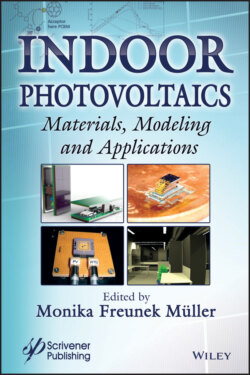Читать книгу Indoor Photovoltaics - Группа авторов - Страница 26
2.3 Thermoelectric Conversion
ОглавлениеThermal energy can be converted to electric energy with thermoelectric generators (TEGs). In their typical design, TEGs consist of semiconductor materials. Thermocouples, that is pairs of p- and n-type legs, are connected in parallel thermally and in series electrically. The main physical effects in TEGs are the Seebeck, Thompson and Peltier effect, respectively, and Joule heating.
A temperature difference ∆Tg in such a thermocouple generates an electric potential. Following the Seebeck effect, the resulting output voltage U for N pairs of thermocouples is
(2.7)
where αs denotes the Seebeck coefficient in [V/K] of the thermocouple.
The ohmic resistance causes thermal losses of an electric current I in a conductor of a resistance R, also known as Joule heating PJ
(2.8)
In a heterogeneous material consisting of materials A and B, an electric flow at the material junction yields a heat flow. This is described by the Peltier effect, where πAB is the Peltier coefficient of the material in [V], with
(2.9)
In a homogeneous material, the emission and absorption of heat due to temperature difference in a conductor is represented by the Thomson effect. The Thomson coefficient in [V/K] is
(2.10)
The influence of these effects on the TEG performance depends on the size, design and the application environment. Freunek et al. have investigated the detailed modeling of the performance of TEG [33].
Any temperature difference of an environment couples into the TEG with a thermal resistance Kg. Kg is optimized when it equals the sum of the coupling resistance of the hot and the cold Th and Tc side of the TEG, respectively, where
(2.11)
The maximum achievable temperature difference decreases with increasing miniaturization. The heat sink needs to be dimensioned in a sufficient size, to make a temperature difference usable for a thermoelectric conversion. The size of the heat sink therefore is mostly the limit to miniaturization in TEG systems.
The maximum power output of a TEG Pout can be approximated to [33]
(2.12)
The thermoelectric figure of merit Z is device specific. Figure 2.3 provides a schematic of a TEG.
The output voltage of TEG typically ranges around a few 100 mV. Therefore, DC/DC converters are required.
In indoor industrial applications, the heat from machines can be used with the room temperature as cold sink. In these applications, and especially if the system size is not limited, TEG systems can achieve output powers in the milliwatt range. The same is valid in cold areas or seasons if the temperature difference between outside and indoors can be made usable. However, in most consumer and office applications, the main source for a temperature potential is the difference between wall temperatures and the room temperature. In this case, a TEG will yield a few microwatts.
Figure 2.3 Schematic of a TEG with n- and p-type legs, and a hot and cold side.
